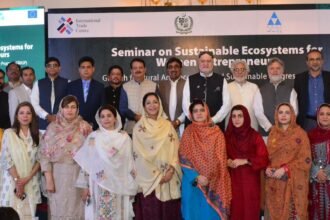Prof. Dr. Mohammad Nafees
The year 2024 was marked the hottest year in human history. This year, the earth’s average temperature rose from 1.5 to 1.6 degrees Celsius. The temperature of the globe has been increasing since the industrial revolution. The 1990s was the hottest decade since 1861, and 1998 was the first year to be recognized as the hottest with 0.58 degrees Celsius above the average global temperature. Although greenhouse gases were being discussed at the time, the El Niño impact was held responsible for the temperature increase. Since then, there hasn’t been a noticeable rise in the mercury level, and environmental degradation and changes haven’t received any special attention. Among greenhouse gases, only carbon dioxide was under discussion, and large scale plantation was recommended as a solution. Over the years rich nations made a commitment to cut carbon dioxide emissions globally under Kyoto Protocol, adopted in 1997, but there is no notable advancement so far. In 2002, the temperature increased by an additional 0.2 degrees Celsius, making it the second-hottest year. The 15-year span from 1998 to 2012 was noted as the hottest period in history, with 2016 being the third-warmest year. A special emphasis was put on lowering greenhouse gas emissions. Since 2002, the temperature has been steadily rising. During 2002-18, the ten hottest years were recorded with fluctuating mercury levels.
The most significant temperature increase was noted in 2022, when 28 countries worldwide declared it to be the warmest year, with an average temperature increase of 1.36 degrees Celsius. The Paris Agreement – 2015-16 was signed in order to maintain the temperature at 1.5. Developed nations have been asked for lowering greenhouse gas emissions under this pact. Reduce the amount of fossil fuels burned and start using sources of clean energy. In 2015 a comprehensive plan in the form of 17 sustainable development goals was compiled for this purpose. It was suggested that by 2030, it should be properly followed.
The year 2022 was a challenging year for Pakistan, first being despised for the prolonged heat wave and then experienced an awful flood. Following 2022, every year started to be reported as the warmest year in history, a trend that persists until the present day. The question of what to do right away or what might occur now emerges when this short history is reproduced. Lowering environmental contamination is all that needs to be done, yet it seems like a huge challenge. No nation is willing to reduce its economy in order to reduce environmental pollution. Second, as a remedy, we are considering solar and other renewable energy sources. Climate change adaptation is the third option we see. To remain mindful of adaptability to the consequences of climate change. For instance, in the event of a water scarcity, consider the water storage and harvesting; in the event of a food shortage, concentrate on the food production. Reducing the population is one hidden option that only a few nations can implement. However, there hasn’t been a noticeable drop in it at the global level at this point. Other than this, we need to think beyond plantations and carbon dioxide. In addition to plantations, we must adopt an integrated approach, consider other greenhouse emissions, substances that deplete the ozone layer, and look for alternative technologies.
Pakistan is among the top 10 countries in terms of climate change impacts but is ranked 31st in terms of environmental performance. As a result Pakistan faces several issues as listed below:
1. In comparison of 2024, there could be an unprecedented increase in air pollution if proper action is not taken. This may lead to an increase in respiratory, gastrointestinal, chest, and skin-related issues.
2. There will also be a major spike in water contamination. Several social, economic, and health problems can result from drought and drinking water shortages.
3. The temperature will continue to rise; the global temperature could go up by 1.8 degrees Celsius, and the average temperature in Pakistan is predicted to go up by 2.18 degrees Celsius. Our summer will become more intense due to this.
4. There is a possibility of raising the intensity of floods by 30 percent. Agriculture production can be affected by 20 to 30 percent due to heat waves and floods, which can result in financial, physical, and mental health issues.
5. The population will increase by 6.5 million, which will further intensify the demand for food items.
Appropriate measures
1. It is necessary to use water with care and reduce its consumption by 50%.
2. Although it is unachievable, population decrease needs to be considered.
3. Open burning solid waste must be avoided.
4. It is crucial to refrain from burning adulterated fuels, particularly used engine oil and tires, at the industrial level.
5. It is necessary to grow trees on the mountains and keep them safe from wildfires.
6. It is important to prioritize sustainable energy sources, particularly solar energy.
7. The most crucial thing is to increase awareness among farmers, businesspeople, industrialists, and everyone concerned to work together, mitigate and adapt to the effects of climate change.
The Author is Department of Environmental Sciences, University of Peshawar










